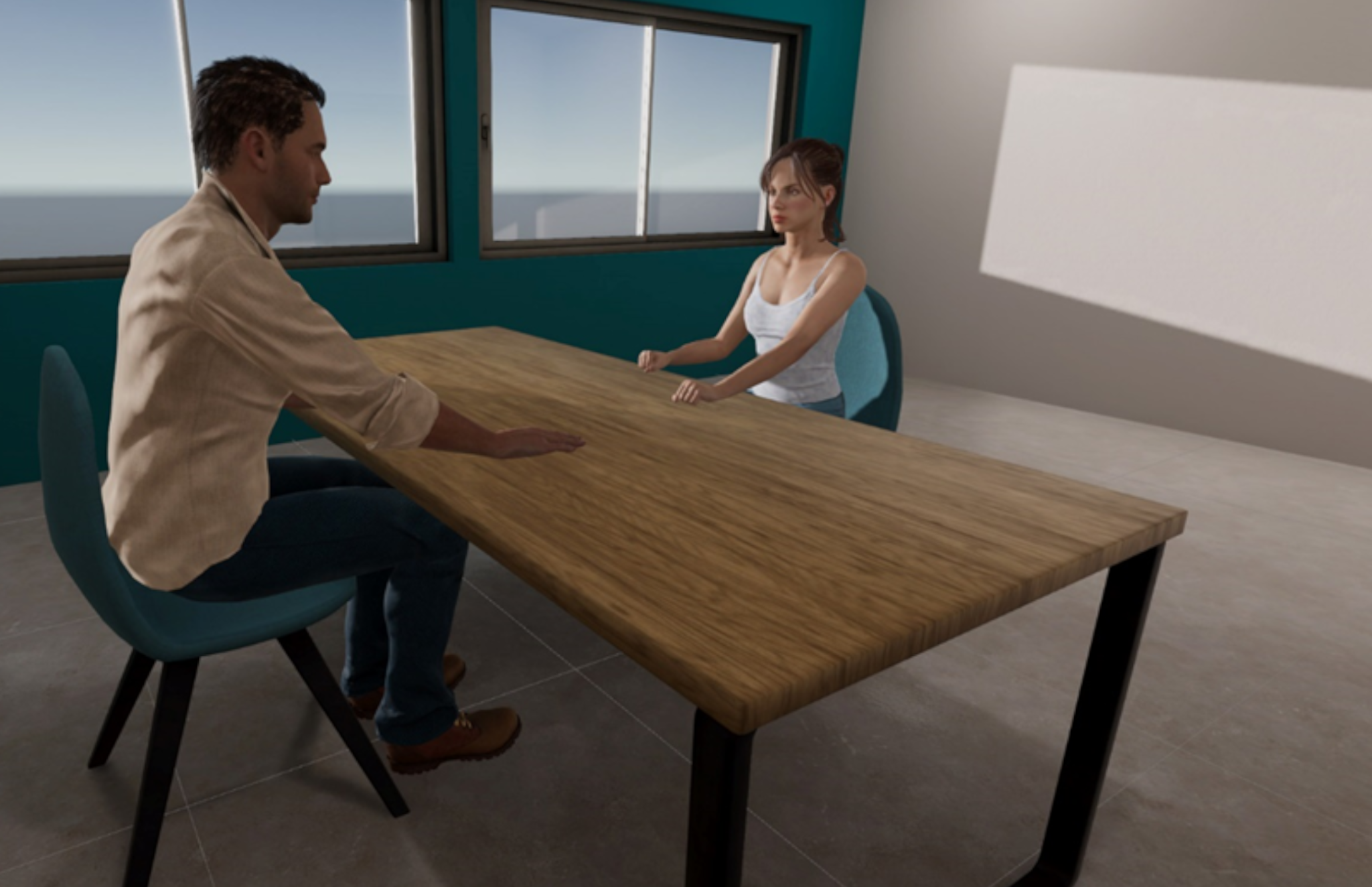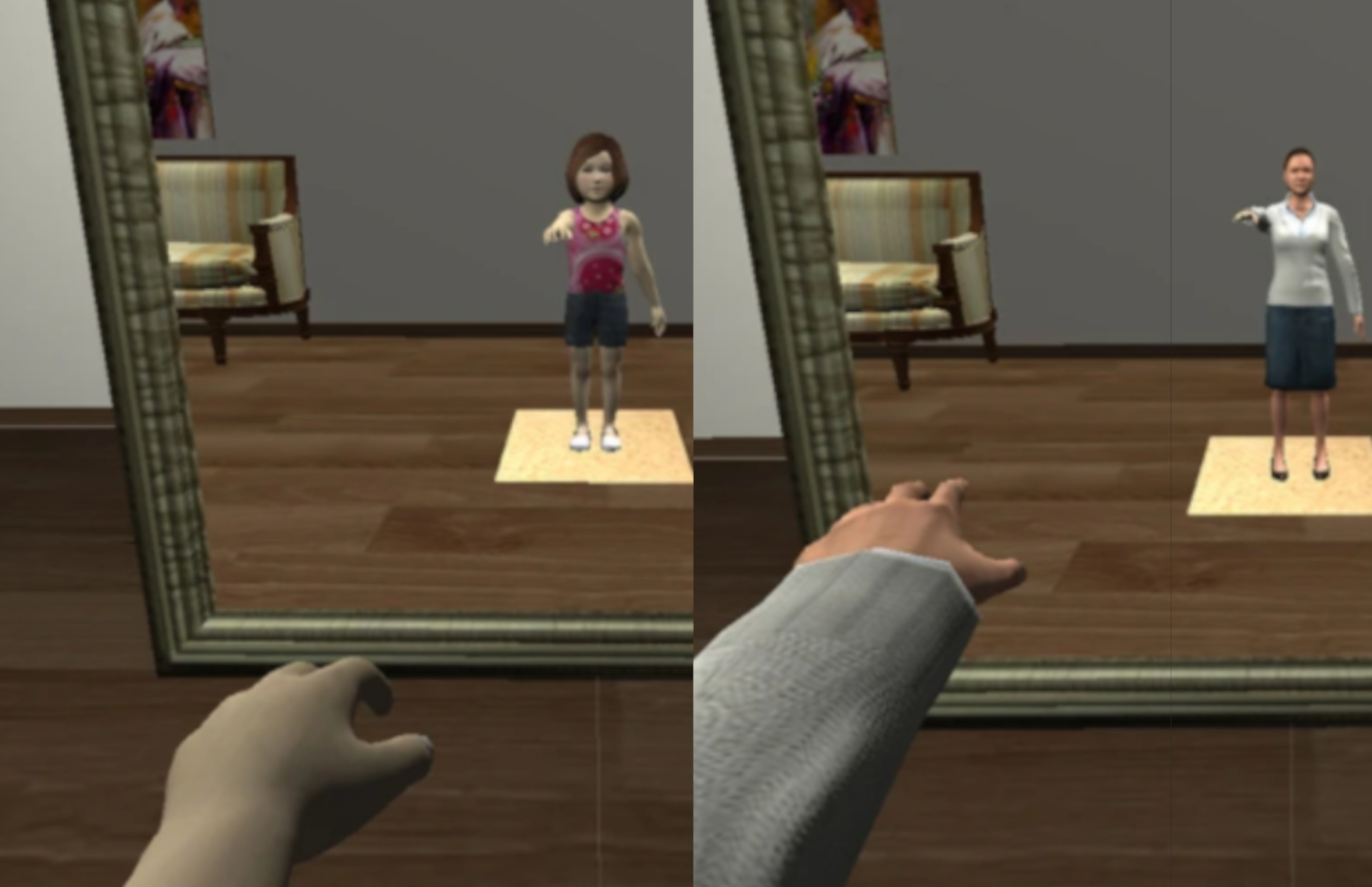VR Projects
Some of the stuff I have worked on.
Journal Articles
2025
Social facilitation within immersive virtual reality enhances perseverance in stroke rehabilitation training.
C Hadjipanayi, D Sokratous, C Kyrlitsias, D Banakou, D Michael-Grigoriou (2025)Front. Virtual Real. 6:1581240.
Virtual Reality in Stroke Rehabilitation and Treatment: Focusing on the Patient’s Experience and Needs.
C Hadjipanayi, D Banakou, D Michael-Grigoriou (2025)In: Charalambous, A. (eds) Critical Perspectives on Technological Innovations in Healthcare. Springer, Cham pp 101-116.
2024
Multisensory experiences of affective touch in virtual reality enhance engagement, body ownership, pleasantness, and arousal modulation.
W Sun, D Banakou, J Świdrak, I Valori, M Slater, M T Fairhurst (2024)Virtual Reality 28, 162.
Development of a Modular Adjustable Wearable Haptic Device for XR Applications.
A Najm, D Banakou, D Michael-Grigoriou (2024)Virtual Worlds 2024, 3, 436-458.
Virtual reality exergames for enhancing engagement in stroke rehabilitation: A narrative review.
C Hadjipanayi, D Banakou, D Michael-Grigoriou (2024)Heliyon, 10:18, e37581
Desensitizing Anxiety Through Imperceptible Change: Feasibility Study on a Paradigm for Single-Session Exposure Therapy for Fear of Public Speaking.
D Banakou, T Johnston, A Beacco, G Senel, M Slater (2024)JMIR Form Res 2024;8:e52212
Cultivating empathy through narratives in virtual reality: a review.
C Hadjipanayi, M Christofi, D Banakou, D Michael-Grigoriou (2024)Personal and Ubiquitous Computing 10.1007/s00779-024-01812-w
2023
Haptic feedback in a virtual crowd scenario improves the emotional response.
RK Venkatesan, D Banakou, M Slater, M Manivannan (2023)Frontiers in Virtual Reality Sec. Haptics 4:1242587
A comparison of two methods for moving through a virtual environment: walking in place and interactive redirected walking.
D Banakou, M Slater (2023)Frontiers in Virtual Reality Sec. Virtual Reality and Human Behaviour 4:1294539
Using virtual reality to assess gesture performance deficits in schizophrenia patients.
A Pavlidou, G Gorisse, D Banakou, S Walther (2023)Frontiers in Psychiatry 14:1191601
Art as therapy in virtual reality: A scoping review.
C Hadjipanayi, D Banakou, D Michael-Grigoriou (2023)Frontiers in Virtual Reality 4:1065863
2022
The Sentiment of a Virtual Rock Concert.
M Slater, C Cabriera, G Senel, D Banakou, A Beacco, R Oliva, J Gallego (2022)in Virtual Reality 23:1-25
A Separate Reality: An Update on Place Illusion and Plausibility in Virtual Reality.
M Slater, D Banakou, A Beacco, J Gallego, F Macia-Varela, R Oliva (2022)Frontiers in Virtual Reality 3:914392
2021
Self-observation of a virtual body-double engaged in social interaction reduces persecutory thoughts.
G Gorisse, G Şenel, D Banakou, A Beacco, R Oliva, D Freeman, M Slater (2021)Scientific Repports 11:23923
The Golden Rule as a Paradigm for Fostering Prosocial Behavior With Virtual Reality.
M Slater, D Banakou (2021)Current Directions in Psychological Science
The Influence of Embodiment as a Cartoon Character on Public Speaking Anxiety.
A I Bellido Rivas, X Navarro, D Banakou, R Oliva, V Orvalho, M Slater (2021)Frontiers in Virtual Reality 11:2281
Evaluating participant responses to a virtual reality experience using reinforcement learning.
J Llobera, A Beacco, R Oliva, G Şenel, D Banakou, Mel Slater (2021)Royal Society Open Science 8:9
Editorial: Neuropsychological and Cognitive-Behavioral Assessment of Neurodegenerative Disease and Rehabilitation Using New Technologies and Virtual Reality.
M Matamala-Gomez, F Stasolla, S Seinfeld, A O. Caffò, D Banakou, S Bottiroli (2021)Frontiers in Psychology 12:691909
2020
Virtual body ownership and its consequences for implicit racial bias are dependent on social context.
D Banakou, A Beacco, S Neyret, M Blasco-Oliver, S Seinfeld, Mel Slater (2020)Royal Society Open Science 7:201848
The Rocketbox library and the utility of freely available rigged avatars for procedural animation of virtual humans and embodiment.
M Gonzalez-Franco, E Ofek, Y Pan, A Antley, A Steed, B Spanlang, A Maselli, D Banakou, N Pelechano, S Orts-Escolano, V Orvalho, L Trutoiu, M Wojcik, M V Sanchez-Vives, J Bailenson, M Slater, J Lanier (2020)Frontiers in Virtual Reality 1:561558
Exploring the effect of cooperation in reducing implicit racial bias and its relationship with dispositional empathy and political attitudes.
I Patané † , A Lelgouarch † , D Banakou † , G Verdelet, C Desoche, E Koun, R Salemme, M Slater, A Farnè (2020)Frontiers in Psychology, 11:2281
Social Conformity in Immersive Virtual Environments: The Impact of Agents’ Gaze Behavior.
C Kyrlitsias, D Michael-Grigoriou, D Banakou, M Christofi (2020)Frontiers in Psychology 11:2254
A Virtual Τour of a Hardly Accessible Archaeological Site: the Effect of Immersive Virtual Reality in User Experience, Learning and Attitude Change.
C Kyrlitsias, M Christofi, D Michael-Grigoriou, D Banakou, A Ioannou (2020)Frontiers in Computer Science 2:23
2019
A Mechanistic Account of Bodily Resonance and Implicit Bias.
R Bedder, D Bush, D Banakou, T Peck, M Slater, N Burgess (2019)Cognition 184 (1-10)
2018
Virtually Being Einstein Results in an Improvement in Cognitive Task Performance and a Decrease in Age Bias.
D Banakou, S Kishore, M Slater (2018)Frontiers in Psychology 9:917
Reducing risk and improving maternal perspective-taking and empathy using virtual embodiment.
C Hamilton-Giachritsis, D Banakou, M Quiroga-Garcia, C Giachritsis, M Slater (2018)Scientific Reports 8:14227
2017
Embodiment in a virtual body that speaks produces agency over the speaking but does not necessarily influence subsequent real speaking.
D Banakou, M Slater (2017)Scientific Reports 7:14227
Embodiment in a Child-Like Talking Virtual Body Influences Object Size Perception, Self-Identification, and Subsequent Real Speaking.
A Tajadura-Jiménez † , D Banakou † , N Bianchi-Berthouze, M Slater (2017)Scientific Reports 7:9637
2016
Virtual Embodiment of White People in a Black Virtual Body Leads to a Sustained Reduction in their Implicit Racial Bias.
D Banakou, PD Hanumanthu, M Slater (2016)Frontiers in Human Neuroscience 10:601
2014
Body ownership causes illusory self-attribution of speaking and influences subsequent real speaking.
D Banakou, M Slater (2014)Proceedings of the National Academy of Sciences U S A (PNAS) 111(49):17678-83
2013
Illusory ownership of a virtual child body causes overestimation of object sizes and implicit attitude changes.
D Banakou, R Groten, M Slater (2013)Proceedings of the National Academy of Sciences U S A (PNAS) 1(6):12846–12851
2011
Computer Based Video and Virtual Environments in the Study of the Role of Emotions in Moral Behavior.
X Pan, D Banakou, M Slater (2011)Affective Computing and Intelligent Interaction 6975:52-61
2010
The effects of Avatars’ Gender and Appearance on Social Behaviour in Virtual Worlds.
D Banakou, K Chorianopoulos (2010)Journal of Virtual Worlds Research 2(5):3-16









